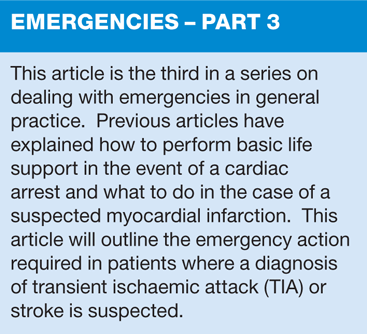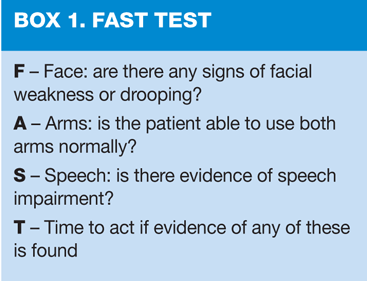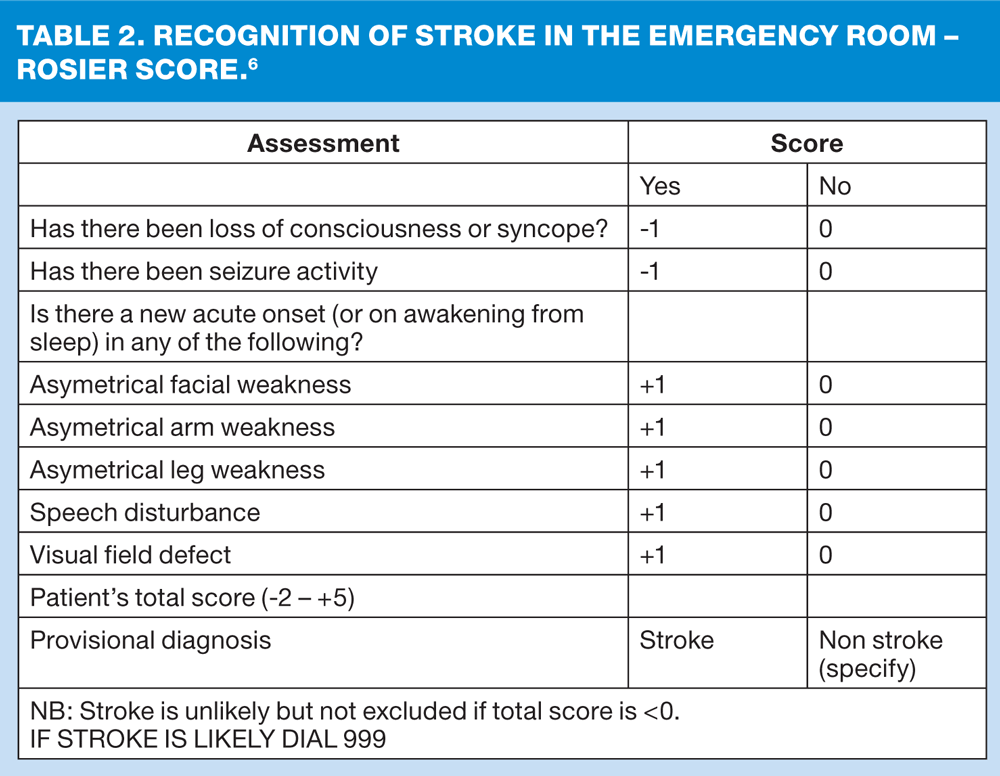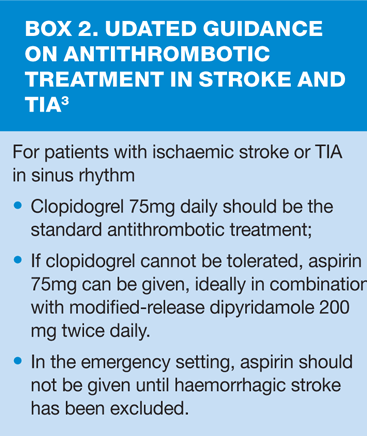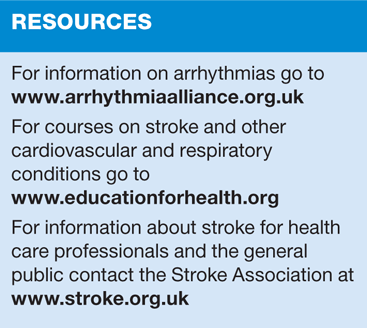Dealing with emergencies in general practice The patient with suspected stroke
Beverley Bostock-Cox
Beverley Bostock-Cox
RGN, BSc, MSc
Nurse Practitioner, Sky Blue Medical Group, Coventry, Clinical Lead, Education for
Health, Warwick
A swift response to patients exhibiting the signs and symptoms of a possible stroke can make a real difference to the significant morbidity and mortality associated with the condition
We were recently reminded of the unexpected and potentially devastating impact of stroke when broadcaster Andrew Marr suffered a stroke at the age of 53. Statistics from the Stroke Association tell us that strokes are a leading cause of death and disability in the UK.1 A swift response to the signs and symptoms of a possible stroke can help to reduce the significant morbidity and mortality associated with the condition. A stroke survivor will have to live with the potential fall-out of the event, including physical, psychological and cognitive impairment. The effects of stroke will be felt not only by the individual but also by their family and carers, and by society in general, in terms of social care costs and loss of earnings for those of working age.
According to the latest Stroke Association figures, 150,000 people suffer a stroke in the UK each year, which equates to one person every 5 minutes. In common with Andrew Marr, 20,000 of these are under the age of 65. Stroke is the third most common cause of death, and the most common cause of severe disability in the UK, affecting more than a quarter of a million people. Stroke occurs when the blood supply to the brain is interrupted in some way. Around three quarters of strokes are caused by a thrombotic event, where a clot blocks the flow of blood to the brain; a much smaller number are caused by bleeding from an aneurysm or other vascular defect.2 Although the underlying causes may be different, the implications for the patient are very similar in terms of the risk of death and disability.
TRANSIENT ISCHAEMIC ATTACKS
The difference between a stroke and a transient ischaemic attack (TIA) is the length of time that the symptoms last for. Stroke symptoms last for at least 24 hours, and usually much longer. TIAs, also known as mini strokes, have the same underlying pathophysiology as a thrombotic stroke, but the effects last less than 24 hours — in most cases the symptoms resolve within a few minutes. They must be seen as a significant warning of future stroke risk, however, and should always be taken seriously. For many people a TIA will be followed by a stroke within the next few days so further follow up should be arranged.3
RECOGNISING ACUTE STROKE
Stroke needs to be treated as a matter of urgency: it is a 'brain attack' rather than a heart attack and both conditions require the same level of urgency when it comes to taking action to preserve tissue. Early recognition of the symptoms is therefore essential.
The National Institute for Health and Clinical Excellence4 recommends using a validated tool such as the FAST test (Box 1) to assess stroke risk in the community setting and a campaign aimed at increasing public awareness of this test was also developed. According to the Royal College of Physicians (RCP), 95% of strokes occur outside hospital.3 The FAST test is quick and easy to initiate and allows the symptoms of possible stroke to be identified and acted upon swiftly, thus reducing the risk of death and disability.
IMMEDIATE ACTION
In cases of suspected stroke
In cases of suspected stroke, where a patient has been identified as being at risk using the FAST test, the following actions are recommended by NICE4 and the RCP.3
- Dial 999 — ambulances should respond rapidly to cases of suspected stroke and transfer the patient to specialist care promptly
- Exclude hypoglycaemia as a possible cause of symptoms
- Maintain the airway as and when required and keep the patient nil by mouth due to possible aspiration risk
- Aspirin 300mg should be given as soon as haemorrhagic stroke has been excluded, and certainly within 24 hours of the event; however, some areas recommend giving aspirin anyway as ischaemic stroke is more likely than haemorrhagic stroke and aspirin may help to reduce morbidity and mortality. You could find out whether you have local guidelines in primary and/or secondary care on giving aspirin in suspected stroke before a scan is carried out.
If people appear to have had a stroke but are FAST negative, they should still be treated as a stroke until proved otherwise by a stroke specialist.
In cases of TIA
In general practice, people may be seen after symptoms have resolved, making TIA a possible diagnosis. The RCP gives the following advice for managing patients who have had a TIA:
- Give antiplatelet treatment i.e. clopidogrel or aspirin 300mg as a loading dose with 75mg subsequently
- Specialist assessment and investigation within 24 hours of onset of symptoms if high risk of stroke (ABCD2 score 4+) or within 1 week if lower risk (ABCD2 score 3 or less).5 (Table 1) Patients seen in emergency departments will often be assessed using the ROSIER score.6 (Table 2)
- Start statin therapy e.g. simvastatin 40mg unless contraindicated
- Introduce other measures for secondary prevention introduced as appropriate
People with crescendo TIA (two or more TIAs in a week) should be treated as being at high risk of stroke, even though they may have an ABCD2 score of 3 or below.
AF AND STROKE RISK — A STITCH IN TIME
One of the most common causes of thrombotic stroke due to clots is atrial fibrillation (AF). AF is the most common cardiac arrhythmia and is due to an electrical fault within the heart which leads to a disordered beat in the heart chambers. As a result of this disordered beat, the ventricles do not eject the blood within them in the normal way and this allows tiny clots to form. These clots may then be pushed out into the narrowed carotid artery, impeding blood flow to the brain. Because of this chain of events, people with AF should be assessed for their stroke risk using a recognised tool such as the ABCD2 score (Table 1), or the CHADS2 or CHA2DS2VASc scoring systems. Information on these two tools can be accessed at http://www.gpnotebook.co.uk/simplepage.cfm?ID=x20110126111352933383
Based on the CHADS2/CHA2DS2VASc score, patients with AF may need antiplatelet or anticoagulation therapy to reduce their stroke risk. Turn to our feature, A Practical Guide to Anticoagulation, page 29.
ONGOING CARE
A thrombotic stroke is the result of several risk factors, many of which are identifiable and treatable before an event happens via innovations such as the NHS Health Check programme. Secondary prevention approaches such as blood pressure and lipid management need to be in place for all patients who have already suffered from a transient ischaemic attack (TIA) or stroke unless contraindicated. Lifestyle interventions aimed at reducing stroke risk include not smoking, maintaining a healthy weight, keeping as active as possible and eating healthily. AF is a significant risk factor for stroke. Strokes associated with AF tend to be more severe with a greater risk of disability and death. Treatment and ongoing management of AF is also essential, then.
CONCLUSION
A suspected stroke should be treated in the same way as a suspected heart attack — by dialling 999 and taking emergency action to preserve life and reduce morbidity while waiting for the ambulance to arrive. On admission to hospital detailed assessment and investigation can then be carried out and thrombolysis and/or medical or surgical treatment will be initiated.
REFERENCES
1 Stroke Association. Stroke statistics (2013). Available at: http://www.stroke.org.uk/resource-sheet/stroke-statistics Accessed January 2013
2 NHS Evidence. Stroke introduction (2013) Available at: http://www.evidence.nhs.uk/topic/stroke Accessed January 2013
3 Royal College of Physicians (2012) National Clinical Guideline for Stroke Available from http://www.rcplondon.ac.uk/sites/default/files/national-clinical-guidelines-for-stroke-fourth-edition.pdf Accessed January 2013
4 National Institute for Health and Clinical Excellence. Diagnosis and initial management of acute stroke and transient ischaemic attack (TIA). CG68 (2008). Available at: http://www.nice.org.uk/CG68 accessed January 2013
5 Johnson SC, Rothwell PM, Nguyen-Huynh NM, et al. Validation and refinement of scores to predict very early stroke risk after transient ischaemic attack. Lancet 2007;369:283-92
6 Nor AM, Davis J, Sen B, et al. The recognition of stroke in the emergency room (ROSIER) scale: development and validation of a stroke recognition instrument. Lancet Neurology 2005;4:727-
Related articles
View all Articles
